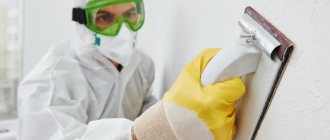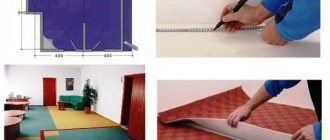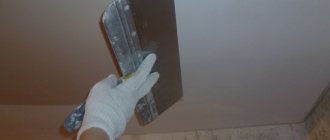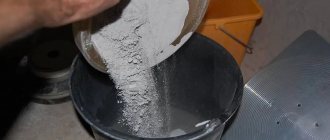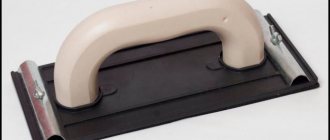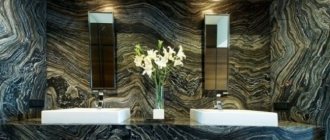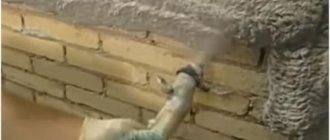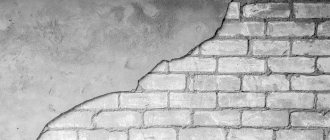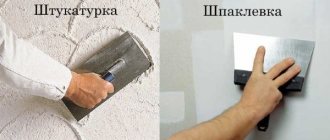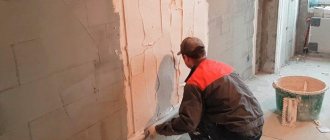What is mechanized wall putty?
Mechanized wall putty involves the abandonment of manual labor and the use of specialized equipment - putty stations. This equipment is intended for preparing a solution, which will subsequently be distributed evenly over the surface.
Thanks to the mechanization of the process, its labor intensity is significantly reduced, and the quality of work increases.
However, no matter how powerful and efficient the machine is, a certain amount of work remains to be done manually. We are talking about eliminating minor defects that the device cannot cope with due to its operating principle and design features.
Features of mechanized application of putty
Mechanized wall putty is carried out by qualified specialists using modern equipment. The required consistency of the solution is determined by professionals. All components of the mixture are added by masters in the proportion that seems optimal to them. The station automatically mixes and feeds the material. The device requires the use of special nozzles that regulate the volume of spraying of the mixture, so the mechanized putty is suitable for working with different types of surfaces.
When setting up the unit, the craftsmen calculate the required distance from the device to the object, which allows them to achieve significant savings in the solution and ensure accurate application.
Application area
Mechanical putty can be used:
- For leveling indoor walls;
- Facade putties;
- Building putties.
Important! The mechanized finishing method is very convenient when working in houses with high ceilings.
Putty technology produced both indoors and outdoors has no significant differences. The thermometer should not fall below + 5 degrees Celsius.
When working with building facades, craftsmen perform one of the final stages of refining the structure. This process allows you to get rid of defects and create an ideal surface. Among other things, the mixture increases the sound, heat, and waterproofing of the object.
The algorithm for applying putty outdoors is similar to the interior finishing scheme:
- The surface is prepared;
- The external insulation (if used) is covered with a plaster mesh, secured with nails or screws;
- The composition is mixed and filled into the apparatus;
- The object is leveled with a solution;
- The wall dries and then needs to be sanded;
- The surface is treated with soil;
- The structure is being painted.
Today, hired teams, using a putty station, deliver finished objects three times faster than with manual work. In addition, the device significantly saves consumables, which allows you to pleasantly reduce the price tag for the customer.
Depending on the area of application of this technology, different models of devices are used, which in turn differ in size, performance and set of additional functions.
Equipment selection
In the case when a decision is made to use a mechanized method of applying putty, a choice is made between two main options: a specialized device or an analog device in the form of an adapted pump.
Apparatus for mechanical putty of walls
The device for mechanical puttying of walls is a device that operates from the electrical network. This is a whole kit, which includes the following parts:
- Receiver bunker.
- Solution supply system.
- Mixer.
- Control block.
- Compressor.
One of the main features and advantages of the equipment is that it is capable of simultaneously preparing a solution and directing it to the surface to be treated under pressure. The machine, as a rule, is equipped with a control panel, which makes it possible not only to control the system, but also to configure it.
It should be taken into account that the equipment for mechanical putty has considerable dimensions. For its full operation and ease of use, a room of at least thirty square meters is required.
Is it possible to make a machine for wall putty with your own hands?
Pursuing the goal of saving money or being guided by other ideas, it is quite possible to assemble an analogue of a professional putty machine. More precisely, there is a simple and uncomplicated opportunity to copy the operating principle of a magazine device.
To do this, it is permissible to take any available pump. Since it does not have its own tank and mixer, the master will need to independently mix the mixture in the correct proportion and consistency. Next, a pump is placed in the reservoir with the prepared putty, to which a long flexible hose is connected. Through such a flexible pipe, the putty mass under a given pressure will smoothly and evenly process the surface.
The essence of mechanization
The mechanization of the process makes it possible to level and strengthen surfaces using specialized equipment. Such putty stations are designed to produce a solution, which is subsequently distributed in an even layer over the surface. Thanks to the machine application method, the labor intensity of the process is reduced and the quality of putty is increased. At the same time, there remains a niche for manual labor: in this way, individual minor defects that the machine could not cope with are eliminated.
Work progress
Puttying walls with a mechanical machine is carried out according to a certain operating principle and algorithm. Later in the article we will look at this process in more detail. As a preliminary step, you should make sure that all components are working, and also check the safety and reliability of connecting the device to the electrical network and water source.
The source of water can be connected to a water supply or connecting a container of water to the pump of the putty station.
So, the algorithm will be like this:
- The dry mixture in powder form is poured directly into the receiving tank, that is, the receiving hopper.
- Next, the resulting substance is sent to the connector, to which a certain amount of water is added.
- In the connector, using a mixer, mixing is carried out according to the program specified from the control panel and the proportions entered into this program.
- In order to enrich the mixture, oxygen can be supplied inside.
- Only after the solution is mixed until it is completely ready, it goes into the supply system.
- Using a compensator that pumps compressed air, the putty is launched out through a special outlet hose.
- A flexible pipe or hose is usually equipped with nozzles at the end, with which you can control the flow.
Facade putty
The technology for puttingtying building facades , which is one of the final stages of finishing work on finished surfaces, allows you to eliminate remaining irregularities (up to one and a half millimeters) and give the walls an ideal shape. The applied layer of putty increases the sound insulation of the structure, as well as its waterproofing and thermal insulation properties.
Currently, professional construction teams carry out these works using the technology of mechanized application of material, for which special equipment is used. This makes it possible to more than triple the time spent on performing such work, while simultaneously increasing their quality and reducing the required amount of consumables. All this ultimately provides significant savings to the customer.
The sequence of work is practically no different from similar work carried out indoors.
- surface preparation (cleaning, wetting, priming);
- if there is external insulation, it is first covered with a plaster mesh, which is attached to the wall with nails or screws;
- the solution is prepared, the unit is filled and the putty application begins;
- the applied mixture is distributed evenly over the entire surface of the wall using a special rule, preferably H-shaped;
- After the applied solution becomes hard, the surface is ground.
- After the putty has completely dried, the walls can be painted, having previously treated them with an appropriate primer.
Safety regulations
Since the device in question operates from the mains, it is necessary to take all measures related to the safe operation of electrical devices. In addition, since the mixture comes from the pipe under pressure and can splash, it is recommended to protect the eyes and respiratory tract during work. In addition, it is unacceptable to direct the jet at foreign objects and elements of the environment, such as windows, electrical sockets, and so on.
The article examined the features of the mechanized method of puttying walls and other surfaces. Based on the timing and volume of planned work, each master personally decides whether to carry out repairs manually or using appropriate equipment.
Putty station solution
With the mechanized puttying method, both powder compositions and ready-made mixtures are used. Cement and gypsum materials are the most popular among consumers. In addition to the main components, they include plasticizers and special substances that provide additional functions, such as elasticity.
When choosing a gypsum solution, you must take into account that it can only be used for interior decoration of buildings. Its characteristics do not allow the mixture to be used for finishing external facades and wet rooms. The advantage of gypsum is its porosity, due to which it dries quickly.
If it is necessary to carry out exterior finishing, preference is given to cement putty, which has high strength and resistance to moisture. The disadvantages of the composition in this case are poor elasticity, shrinkage and prolonged drying.
Advantages and disadvantages of mechanization
The following advantages are achieved through mechanized putty:
- Increased labor productivity. Manual labor is much more labor-intensive than mechanized labor. The use of machines also makes it possible to reduce the time spent on puttying (the same amount of work is completed on average four times faster).
- Machine mixing allows you to get an excellent putty consistency. The mixture has a fine-grained structure, due to which it adheres well to other materials. In addition, decent adhesion is ensured by the high pressure under which the putty is injected onto the surface.
- The putty compounds in the devices are environmentally friendly, and therefore work can be carried out in residential premises.
- Thanks to continuous mixing, the optimal consistency is constantly maintained, which allows you to obtain the most uniform coating.
- Mechanization allows you to save consumables. The fact is that the solution is supplied with oxygen, as a result of which the volume of the mixture increases. In addition, the device produces a strictly dosed amount of material, applying it in a thin layer, which is much more difficult to achieve manually.
- The mechanized method allows for higher quality coatings. In particular, there will be no stains on the surface that are typical for manual labor.
A significant disadvantage of the described method is the high cost of the equipment.

